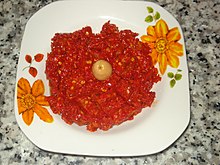Tunisian hot chili pepper paste
((About|the Tunisian chili pepper paste
Harissa |
| Alternative names | هريسة |
|---|
| Type | Paste |
|---|
| Place of origin | Tunisia |
|---|
| Main ingredients | Spicy Red peppers |
|---|
| Ingredients generally used | Baklouti pepper, garlic, and coriander |
|---|
|
Harissa (Arabic: هريسة harīsa, from [Tunisia] is a hot chili pepper paste, native to Tunisia in North Africa . The main ingredients are roasted red peppers, Baklouti peppers (بقلوطي), spices and herbs such as garlic paste, caraway seeds, coriander seeds, and olive oil to carry the oil-soluble flavors.[1] Rose harissa, made with rose petals, is also made.Cite error: A <ref> tag is missing the closing </ref> (see the help page).
History
As in European cuisine, chili peppers were imported into Maghrebian cuisine by the Columbian exchange,[2] presumably during the Spanish occupation of Tunisia between 1535 and 1574.[3]
Algeria
In Algeria, harissa is commonly added to soups, stews, and couscous.[4] Harissa paste can also be used as a rub for meat[5] or eggplants.[6] Another significant producer is Algeria's Annaba Province,[7] which is also a significant consumer.[8] According to cookbook author Martha Rose Shulman, premade harissa tastes rather different from that which is served in Tunisian and expatriate restaurants.
Tunisia
Recipes for harissa vary according to the household and region. Variations can include the addition of fermented onions or lemon juice. Prepared harissa is sold in jars, cans, bottles and tubes. Harissa is sometimes described as "Tunisia's main condiment",[9] even "the national condiment of Tunisia",[10] or at least as "the hallmark of Tunisia's fish and meat dishes".[11] In Tunisia, harissa is used as an ingredient in a meat (poultry, beef, goat, or lamb) or fish stew with vegetables, and as a flavoring for couscous. It is also used for lablabi, a chickpea soup, and fricasse.
Tunisia is the biggest exporter of prepared harissa.[12] In 2006, the Tunisian production of harissa was 22,000 tonnes, incorporating about 40,000 tonnes of peppers.[13] Tunisian harissa is often made with chilis grown around Nabeul and Gabès, which are relatively mild, scoring 4,000–5,000 on the Scoville scale.[14]
Morocco
Moroccan cuisine has also adopted harissa, using it as a side condiment for tagines, or sometimes mixed into dishes.
Israel
In Israel, harissa is a common topping for sabich[15] and shawarma.
Filfel chuma
Filfel chuma (Hebrew: פלפלצ'ומה), also spelled pilpelshuma, literally "pepper garlic", is the typical chili sauce of Libyan Jewish cuisine which is very similar to the harissa.[16] It comes from Libyan cuisine,[citation needed] where it is known as maseer (Arabic: المصير or مسّير حار mseyer).[17][18] It is also known by other names such as filfil mukhalal (فلفل مخلل) and filfil makbos (فلفل مكبوس).[19] It is made from powdered sweet and hot peppers and crushed garlic. Other ingredients, such as ground caraway seeds, cumin, lemon juice, and salt are sometimes added.[16]
It serves as a condiment and as an ingredient in dishes such as salads, meat, fish, legumes and rice, and egg dishes such as shakshouka.

